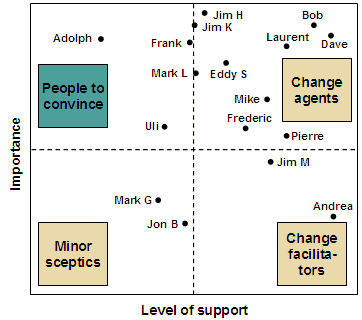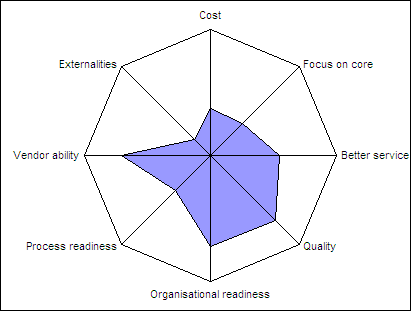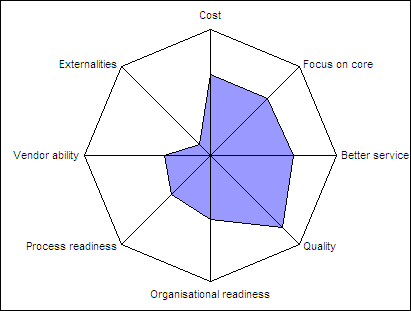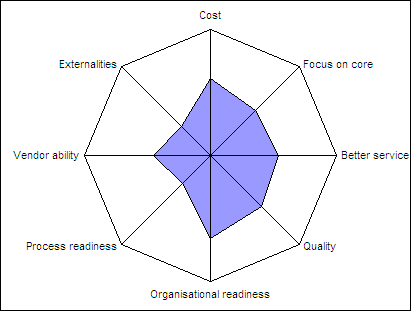Change management can be analytic, as opposed to touchy-feely.
Our client’s operating margin was falling. The bosses wanted to offshore their back office. Others weren’t convinced. To manage this change, we needed three questions answered:
- Who’s not convinced?
- Why aren’t they convinced?
- What’ll convince them?
Who’s not convinced?
We plotted the level of support and importance of key people on the stakeholder support matrix. This split people into 4 groups (below). Then we showed it around to people and had them move people around on the matrix.
- Minor sceptics. We largely ignored them
- Change facilitators. We tasked them with roles in the project
- Change agents. We made them influence the others
- People to convince. The ones we needed to focus on
This is a simple concept, actually. The insight is, putting names on such a matrix, and getting people to move them around, is a robust way to get everyone on the board and at the right spot.
Why aren’t they convinced?
We sent everyone a list of benefits and issues in outsourcing. They rated them. We grouped the results and plotted them. Here’s the result for Uli.
Uli saw more issues than benefits. Quality and possible better service were benefits. But he was afraid the company wasn’t ready, and vendors wouldn’t understand their operations.
The advantage of these charts is that you can put them side by side, and compare where different people stand. It gives you a great view of why they’re objecting, and whom you can use to counter that.
What’ll convince them?
Once we knew why people objected, it was easy to manage.
For example, to counter Uli’s fear of organisational readiness, we got people who felt this was not an issue to put forward their counterpoints.
To counter fears of vendor ability, we got a bunch of them to visit BPOs in India, and spread their confidence to others.
We arranged workshops, making sure that each group had people to convince and change agents.
This did require a lot of soft skills. But the success was largely because of the structured ground-work. Change management can be quite analytic.




cool work..something similar to stakeholder mapping rite.but how did u achieve the moving around of people within the matrix .was it a group exercise.is there any chance of a bias entering the analysis ? how did u arrive at the final stakeholder map? i did a study for scorttish power on wind power..we didnt exactly conclude the arguement as i didnot know how to achieve the support of the stkeholders or the OR way of achieving it..this could have surely helped if it had come 10 days ago anand..really cool
Excellent. Soft-skills help a lot, but this kind of effort goes a long way in assuaging skeptics. Thanks for sharing.
Very neat. I am going to try and use this if the opportunity presents itself. Thanks! Btw, can you share a little more info on the company that’s using the wiki?
Arun, I’m afraid I don’t know much more about them myself. Just that there are examples that my colleague vouches for. Infosys is going for an internal wiki initiative as well.
The octagonal chart is confusing at first. Isn’t there a better way of plotting the issues/benefits poll results ?
Definitely! Variants of the bar chart could have done the job much better. We were pressed for time, though, and we felt cool showing spider graphs to the client… 🙂
Ah, alright. Wipro had tried blogs for a while, i think it died out pretty soon. Interesting, infy going for a wiki initiative. Hope you guys fare better! 🙂
Honestly, I dont have numbers to prove but I feel this outsourcing is breaking into other’s “rice bowl”…but change is change..
What strategy did u use for the people on the middle ground. In your e.g Jim K and Mark L can go either way (People to convince or change agents) ?
Jayant, you’re right. When we were working on this case, we went out to lunch at a restaurant. Behind us were 5 people who’d been laid off by this client 6 months ago. I overheard their conversation. They still hadn’t found a job. Even daily living was proving tough. There’s no doubt: outsourcing hits a lot of people directly, and hard.
Sumeet, Jim H and Jim K were the top people in the company. We didn’t want to “counter” them with anyone having strong opinions. It was vital not to THRUST anything on these two. We asked them for their initial reactions and questions, went back, spent a LOT of time preparing answers, and had conversations with them. We moved gently, and gave them a lot of time. And that’s where the soft stuff comes in.
Actually there is interesting parallel to what happened to Indian textile industry in early 1900. Powerloom’s shirts were cheaper than handloom’s. So, Indian weavers were losing jobs to English powerloom workers. Not that powerloom workers were well off. You may want to read Autobiography of Gandhi for that. Interestingly, then there was Swadeshi movement etc and Indian business community infact had said that it does not make sense to stop imports as it cheaper and people will buy what is cheap and good. Lot of parallels actually. Anyway, guess people who moved to West and probably toiled are probably better off. Hell for one generation, probably heaven for next!
Hey, that’s an interesting perspective!
deamand draft